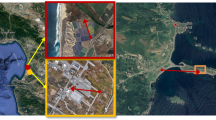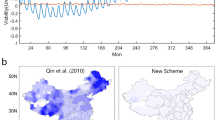Abstract
In this study, we measured the droplet size distribution (DSD) and visibility of sea fog using a fog droplet spectrometer and visibility meter, respectively, during the July 23–August 3 and August 22–September 13 periods of the 2016 Chinese National Arctic Research Expedition. We calculated the visibility using the Mie theory and the DSD data and then compared the calculated with the observed visibility. The comparison shows that the deviations in the calculated visibility caused by DSD data sampling errors cannot be ignored. During navigation, wind and ship speeds tended to push or pull the sampled air and cause turbulence pulsation, which influenced the sampling of the fog droplet spectrometer. This influence is weak when the liquid water content (LWC) is high but becomes stronger as the LWC decreases. Taking the sailing speed and heading into consideration, the wind speed component parallel and perpendicular to the air inlet of the fog droplet spectrometer exhibit different laws in the deviation. By performing a fitting analysis of the calculated and observed visibilities under different wind speeds and wind directions, here, we present two sets of correction coefficients for the two wind-speed components and a method for correcting the calculated visibility. This correction method shows excellent results.
Similar content being viewed by others
References
Eldridge, R. G., 1971. The relationship between visibility and liquid water content in fog. Journal of Atmospheric Sciences, 28 (7): 1183–1186.
Garland, J., 1971. Some fog droplet size distributions obtained by an impaction method. Quarterly Journal of the Royal Meteorological Society, 97 (414): 483–494.
Gultepe, I., Kuhn, T., Pavolonis, M., Calvert, C., Gurka, J., Heymsfield, A. J., Liu, P. S. K., Zhou, B., Ware, R., Ferrier, B., Milbrandt, J., and Bernstein, B., 2014. Ice fog in Arctic during FRAM–Ice Fog Project: Aviation and nowcasting applications. Bulletin of the American Meteorological Society, 95 (2): 211–226.
Gultepe, I., Tardif, R., Michaelides, S. C., Cermak, J., Bott, A., Bendix, J., Müller, M. D., Pagowski, M., Hansen, B., Ellrod, G., Jacobs, W., Toth, G., and Cober, S. G., 2007. Fog research: A review of past achievements and future perspectives. Pure and Applied Geophysics, 164 (6-7): 1121–1159.
Houghton, H. G., and Radford, W. H., 1938. On the measurement of drop size and liquid water content in fogs and clouds. Papers in Physical Oceanography and Meteorology, 6 (4): 10–29.
Koracin, D., Dorman, C. E., Lewis, J. M., Hudson, J. G., Wilcox, E. M., and Torregrosa, A., 2014. Marine fog: A review. Atmospheric Research, 143: 142–175.
Koschmieder, H., 1924. Theorie der horizontalen Sichtweite. Beitrage zur Physik der freien Atmosphare, 12: 33–53.
Kumai, M., 1973. Arctic fog droplet size distribution and its effect on light attenuation. Journal of the Atmospheric Science, 30 (4): 635–643.
Lentz, W. J., 1976. Generating Bessel functions in Mie scattering calculations using continued fractions. Applied Optics, 15(3): 668–671.
McCartney, E. J., 1976. Optics of the Atmosphere: Scattering by Molecules and Particles, Book Review. John Wiley and Sons, Inc., New York, 1–421.
Melchor, C. V., 1941. The Refractive index of liquid water in the near infra-red spectrum. Journal of the Optical Society of America, 31 (3): 244.
Mie, G., 1908. Beiträge zur Optik trüber Medien, speziell kolloidaler Metallösungen. Annalen der Physik, 330 (3): 377–445.
Ogiwara, S., and Okita, T., 1952. Electron microscope study of cloud and fog nuclei. Tellus, 4 (3): 233–240.
Palm, S. P., Strey, S. T., Spinhirne, J., and Markus, T., 2010. Influence of Arctic sea ice extent on polar cloud fraction and vertical structure and implications for regional climate. Journal of Geophysical Research: Atmospheres, 115: D21209.
Roach, W. T., 1976. On the effect of radiative exchange on the growth by condensation of a cloud or fog droplet. Quarterly Journal of the Royal Meteorological Society, 102 (432): 361–372.
Shen, J. Q., and Liu, L., 2005. An improved algorithm of classical Mie scattering calculation. China Powder Science and Technology, 11 (s1): 45-50 (in Chinese with English abstract).
Shupe, M. D., and Intrieri, J. M., 2004. Cloud radiative forcing of the Arctic surface: The influence of cloud properties, surface albedo, and solar zenith angle. Journal of Climate, 17 (3): 616–628.
Spiegel, J. K., Zieger, P., Bukowiecki, N., Hammer, E., Weingartner, E., and Eugster, W., 2012. Evaluating the capabilities and uncertainties of droplet measurements for the fog droplet spectrometer (FM-100). Atmospheric Measurement Techniques, 5 (9): 2237–2260.
Venne, M. G., Jasperson, W. H., and Venne, D. E., 1997. Difficult Weather: A Review of thunderstorm, fog and stratus, and winter precipitation forecasting. Augsburg Coll Minneapolis MN Center for Atmospheric and Space Sciences, Minneapolis, 1–54.
Wang, B. H., 1983. Sea Fog. China Ocean Press, Beijing, 1–102 (in Chinese).
Wiscombe, W. J., 1980. Improved Mie scattering algorithms. Applied Optics, 19 (9): 1505–1509.
Acknowledgements
This work was supported by the National Natural Science Foundation of China (No. 41330960), the National Major Science Project of China for Global Change Research (No. 2015CB953900), and the Major State Basic Research Development Program (No. 2016YFC1402702).
Author information
Authors and Affiliations
Rights and permissions
About this article
Cite this article
Liu, Y., Zhao, J. A Correction Algorithm for Atmospheric Visibility Based on Fog Droplet Size Data Obtained on a Moving Ship During 2016 Arctic Cruise. J. Ocean Univ. China 18, 596–604 (2019). https://doi.org/10.1007/s11802-019-3885-7
Received:
Revised:
Accepted:
Published:
Issue Date:
DOI: https://doi.org/10.1007/s11802-019-3885-7




